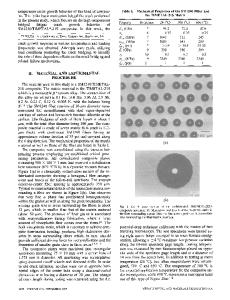Prediction of thermomechanical fatigue lives in metal matrix composites
- PDF / 1,296,998 Bytes
- 10 Pages / 597 x 774 pts Page_size
- 65 Downloads / 348 Views
I.
INTRODUCTION
IN many high-temperature applications, the increased demands for dimensional stability, high-temperature strength, and thermomechanical fatigue resistance are not met through use of conventional materials. Metal matrix composites are candidate materials for high-temperature use; they possess higher strength-to-density ratio, improvements in fatigue crack growth resistance, higher stiffness, and lower coefficients of thermal expansion compared to their monolithic counterparts. However, the behavior of these materials as a function of their constituent properties is not well established. Once this relationship is better understood, it will be possible to design the materials to suit specific applications and to achieve higher reliability than with the monolithic metals. An understanding of the thermomechanical cyclic deformation behavior of metal matrix composites is of significant importance. At elevated temperatures, a multitude of damage mechanisms are synergistically combined to decrease the service lives of the components. The internal stresses and strains due to mismatch in the mechanical and thermal properties of the constituents further contribute to the mechanisms of deformation. This study will explore several micromechanisms of damage in metal matrix composites, including creep, fatigue, and oxidation. In particular, we will study silicon carbide particulate-reinforced A1 2xxx-T4, noting that the ideas developed will be general enough that they may be applied to other materials and reinforcements. In early studies on monolithic materials, damage HUSEYIN SEHITOGLU, Professor, Depat~nent of Mechanical and Industrial Engineering, University of Illinois at Urbana-Champaign, is temporarily Director, Mechanics and Materials Program, National Science Foundation, Washington, DC 20550. METIN KARAYAKA, Visiting Research Associate, is with the College of Engineering, University of Illinois at Urbana-Champaign, Urbana, IL 61801. Manuscript submitted August 9, 1991. METALLURGICAL TRANSACTIONS A
mechanisms occurring under thermomechanical fatigue (TMF) loading were studied. The results showed that isothermal fatigue experiments may not expose many important damage micromechanisms under varying temperature conditions, t~ 71 Crack growth behavior [8-j3~ and oxide rupture behavior at surface and crack tips [4-7'14'151 vary depending on the mechanical strain-temperature phasing. Damage micromechanisms occurring under creep-fatigue cycling include intergranular damage rl61 (r-type, nucleation and growth of grain boundary cavities without aid from a major crack) and triple point cracking t~71(w-wedge type, associated with grain boundary sliding). The creep damage increases with an increase in maximum temperature, an increase in stress or strain hold time, or an increase in tensile hydrostatic stress at the high-temperature end of the cycle. For metal matrix composites, internal stresses and strains generated due to mismatch of mechanical and thermal properties of the constituents will alter the creep, fatig
Data Loading...











